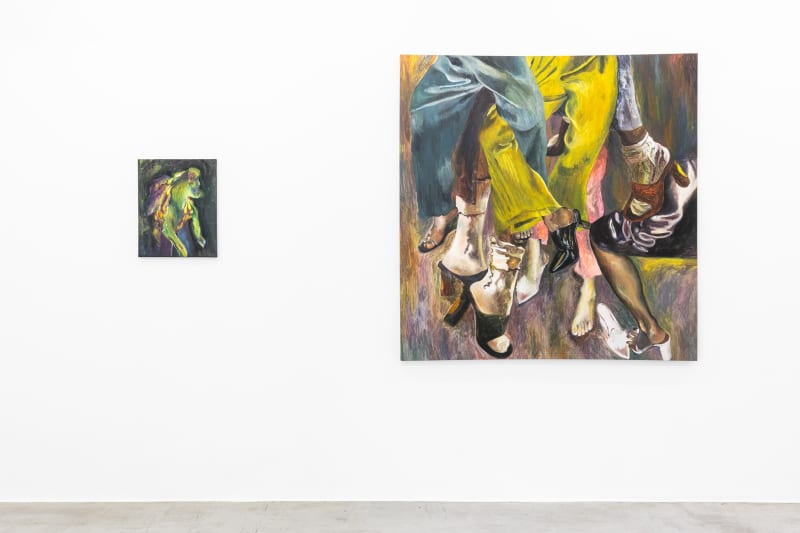Before designating the well-known scam[1], “Good Night, Cinderella” was the title of a sketch on Silvio Santos's television program, aired in the 1970s and 1980s. During each episode, the host interacted with three girls, ages between 3 and about 5 years old, candidates for the role of Cinderella that night. The chosen one was announced with the hug of a prince – represented by a slightly older boy – and had her dream come true: usually, getting a doll, a bicycle, a sewing machine ... There are not many images of the program on online video sharing platforms. In one of the rare excerpts available, we see the three-year-old Ketlin, mesmerized with her own image on one of the recording studio's television sets.[2] Delighted by the electronic image of herself, Ketlin resists looking at the flesh-and-blood presenter. This brief and powerful scene reveals a crucial aspect, both of the criminal act of drugging an unknown person unbeknownst to her, and of Giulia Puntel's poetics.
Everything revolves – in the scam as in Puntel's painting – around the centripetal force of images. Seductive, friendly or harmless-looking, the con artist builds his face as a bait-image that will transform his victim into a kind of little Ketlin, captured and vulnerable to the image. In The Expression of Hands (1997), Harun Farocki comments on a scene from Samuel Fuller's Pickup on South Street (1953) in which we see a man who, with a gallant look and smile, seduces a young lady on the subway while, with slight hands, steals her wallet. The German director reveals a difference between the close-up of the hands and the close-up of the face, inscribing a tension between such images. Often, the voice says off-camera, the image of the hands expresses something the face tries to hide. Paradoxically, the image of the face – a portrait – replaces a person's wholeness, by representing it, something that, in the context of figuration, does not occur with any other part of the body. Giulia Puntel's images are fed by this tension between an identity-based regime of images, grounded on representation and recognition, and a gestural regime, the catalyst of affective experiences that are irreducible to language.
At first, the force that exerts upon our relationship with Puntel's paintings is centrifugal. Visual elements that could activate a relationship based on the recognition of an identity or emotion are positioned virtually, in the space beyond the canvas. This way of composing images refers more to the framing of cinema than to the tradition of figurative painting, whose compositions have often been organized according to the boundaries of the canvas that contained them. The off-screen space – which cinema may or may not make visible as its narrative unfolds – remains an unsolvable mystery in Giulia Puntel's paintings. In this sense, the works shown in good night, cinderella do not offer the viewer a narrative. They establish an atmosphere that remains suspended, thanks to the very pictorial condition of these images.
If Giulia Puntel's composition-framing of the scenes pushes us out of the frame (or backwards, in the case of prato do dia[dish of the day]), the artist uses two strategies that pull us back to the surface of her images. One of them unfolds in the figurative plane and consists in the creation of ambiguous characteristics, which inscribe their characters within the limits between the human and the animal. The purple character we see in Briguelas [Small fights], the yellow figure in O amigo[The friend] and the character's hairstyle in Espelho [Mirror] prevent our gaze from getting lost in a search addicted to narrative and meaning. These characteristics mobilize us not for the meaning we could ascribe, symbolically or culturally, to them; they exert upon us the magnetizing effect that a knife-eater or bearded woman exert on the circus spectator.
The other strategy unfolds in the formal and material plane of her production, through the use of a technique that does not intend to sublimate the pictorial condition of these images. Thus, the artist modulates our perception, causing it to oscillate between the tensions that a film thriller posits between the spaces inside and outside the frame, and the immanent attention that the enjoyment of a modernist painting demands. But this dialogue with the foundations of painting is not, in Giulia Puntel's poetics, at the service of a new formalism. Rather, it is a strategy for slowing down the high volume of high-resolution images that quickly passes through the various feeds that saturate our field of vision and set us in a state of lethargy and numbness, bringing us closer to some characters in Puntel’s painting and little Katlin, at the very moment she becomes surprised with herself on the television screen. This inevitable loss of consciousness facing an image was already foretold, in the 1970s, in the chorus of Silvio Santos's opening song: “Good night, Cinderella, it's time for you to dream…”
Icaro Ferraz Vidal Junior
[1] “Good night, Cinderella” is a Brazilian contemporary slang for Rohypnol, GHB, or any drug that incapacitates another person rendering them vulnerable to assault or robbery.

